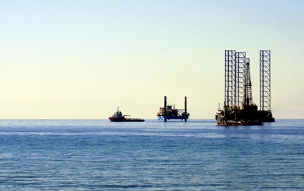Egypt's Nooros Hits Target Early
Eni said September 12 that its Nooros field offshore Egypt's Nile Delta has reached a production of 700mn ft3/d only a year after it started production.
It said this gross production figure equated to 128,000 barrels of oil equivalent per day (boe/d), of which 67,000 boe/d was net to Eni.
Nooros was discovered in July 2015 and put into production in September 2015. It reached this level ahead of schedule: in May it produced 65,000 boe/d and was only expected to hit 120,000 boe/d by end-2016. The field is currently producing from seven wells but, with the drilling of additional wells, is expected to reach a maximum production capacity of about 160,000 boe/d in spring 2017.

Eni drilling this summer offshore Egypt in the Greater Nooros area (Photo credit: Eni)
Eni adds that, thanks to the mature operating environment and the conventional nature of the project, Nooros production costs are "among the lowest in its portfolio" The field is operated by Petrobel on behalf of Nidoco company, a joint venture between IEOC, BP and the state company Egyptian General Petroleum Corporation (EGPC). Eni’s subsidiary IEOC, which holds a 75% stake in the concession while BP holds the remaining 25%.
Gas and condensate from Nooros are piped to Abu Madi’s treatment system, 25km from the discovery, and then allocated in the Egyptian network.
Eni's equity production in Egypt in 2015 was some 200,000 boe/d but this is expected to rise steeply. Earlier this month the Italian company reported “steady progress” in development of its giant 30 trillion ft3 offshore Zohr field, still on target to produce first gas by end-2017, with an initial plateau rate of 1bn ft3/d. Zohr production will then be expanded in phases to reach some 2.8bn ft3/d by 2019/2020.
New offshore fields mean that Egypt now expects to double its gas production by around 2020. Until this happens, it is also importing LNG at two terminals on the Red Sea coast at Ain Sokhna to satisfy domestic demand, as the country is rapidly expanding its gas-fired power generation capacity.
Mark Smedley


